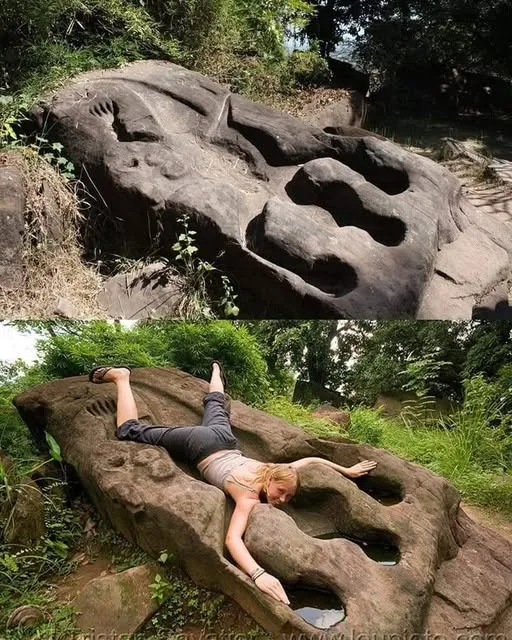Here in Phnom Penh, as we navigate our bustling city, it’s easy to forget the profound history that ripples just beyond our borders, within the very fabric of Southeast Asia. Today, let’s embark on a journey, not just across kilometers to southern Laos, but back through centuries, to a place where ancient stone holds a dark and captivating secret: the Crocodile Stone at the magnificent Vat Phou Temple complex.
Take a moment to look at this peculiar rock formation:

In the upper part of the image, we see a large, weathered stone, lying amidst lush greenery. Its surface bears the unmistakable, if somewhat eroded, carving of a crocodile. The ancient craftsman utilized the natural contours of the rock, allowing the creature’s form to emerge organically from the stone.
But it’s the bottom panel that truly sends a shiver down the spine. Here, a person lies stretched out on the stone, fitting eerily into carved depressions. This human scale instantly brings the ancient theories to life, emphasizing the size of the stone and hinting at a chilling possibility that has fascinated archaeologists and visitors for generations.
This is the legendary Crocodile Stone, nestled within the UNESCO World Heritage site of Vat Phou, a sprawling complex of Khmer temples and ancient ruins in southern Laos. While the grandeur of Vat Phou largely reflects its later Khmer Empire development, this particular stone whispers of a much older, darker era: pre-Angkorian times, specifically before the 9th century CE.
For centuries, local legends and historical speculation have pointed to the Crocodile Stone as a site of profound, and perhaps gruesome, ritual. It is widely believed to have been the location of annual human sacrifices. Imagine the scene over 1,200 years ago: amidst the dense jungle, under a watchful sky, rituals were performed on this very stone, perhaps to appease deities, ensure good harvests, or maintain cosmic balance.
The choice of a crocodile carving is significant. In many ancient Southeast Asian cultures, the crocodile held powerful symbolic meaning, often associated with water, fertility, creation, and sometimes, the underworld or the raw, untamed forces of nature. To offer sacrifice upon a stone effigy of such a potent creature would have been an act of immense spiritual weight.
The depressions on the stone, where the person in the image so eerily fits, are thought by some to be channels or basins designed to collect blood, further fueling the theories of ritual sacrifice. While definitive archaeological proof of human sacrifice from such an early period can be elusive, the combination of oral traditions, the iconography on the stone, and the deeply sacred nature of the Vat Phou site lends significant weight to these chilling speculations.
The Crocodile Stone is a powerful reminder of the diverse and sometimes confronting aspects of ancient beliefs and practices. It speaks to a level of technological sophistication in stone carving that existed long before the famous temples of Angkor Wat, and to a spiritual world vastly different from our own.
For those of us in Phnom Penh, the story of the Crocodile Stone resonates with a shared cultural heritage of ancient kingdoms, intricate belief systems, and monumental stone works that dot our landscape. It beckons us to consider the echoes of the past that still linger in the very earth beneath our feet, reminding us that every stone, every ruin, has a story to tell – some more haunting than others. The mystery of the Crocodile Stone remains, inviting us to contemplate the profound and sometimes unsettling truths about humanity’s journey through time.





